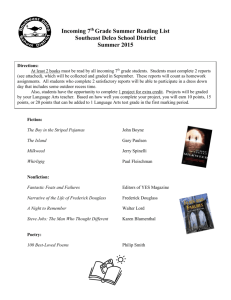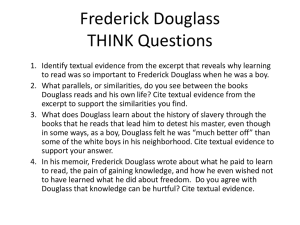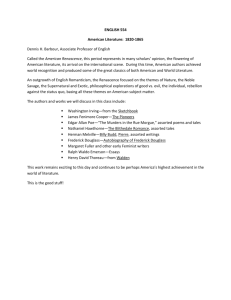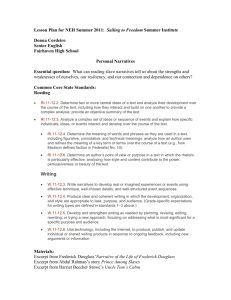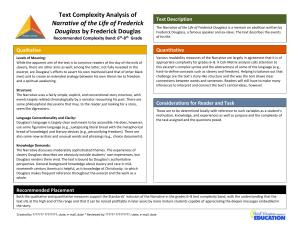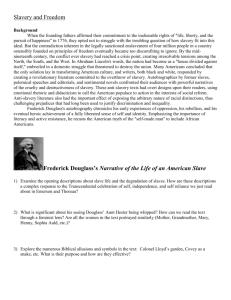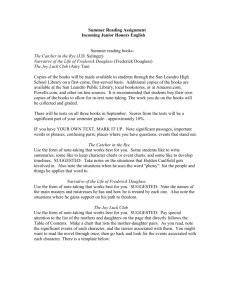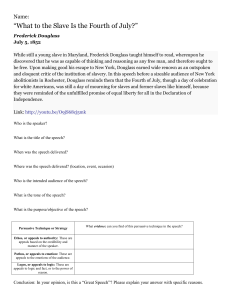Replace This Text With The Title Of Your Learning Experience
advertisement
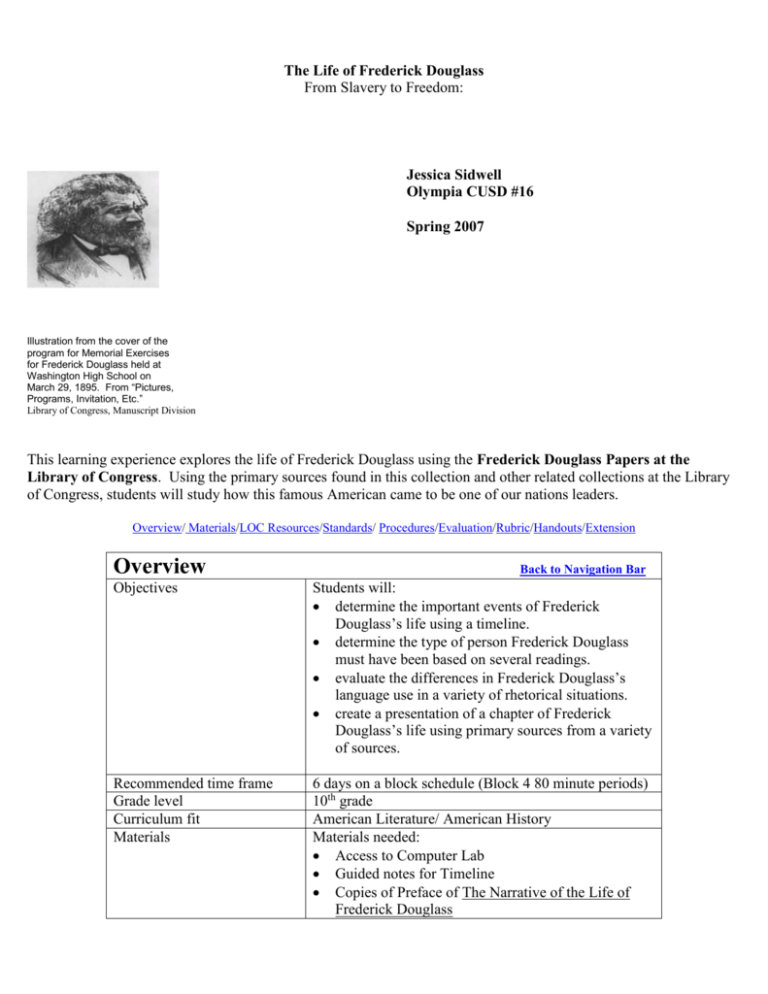
The Life of Frederick Douglass From Slavery to Freedom: Jessica Sidwell Olympia CUSD #16 Spring 2007 Illustration from the cover of the program for Memorial Exercises for Frederick Douglass held at Washington High School on March 29, 1895. From “Pictures, Programs, Invitation, Etc.” Library of Congress, Manuscript Division This learning experience explores the life of Frederick Douglass using the Frederick Douglass Papers at the Library of Congress. Using the primary sources found in this collection and other related collections at the Library of Congress, students will study how this famous American came to be one of our nations leaders. Overview/ Materials/LOC Resources/Standards/ Procedures/Evaluation/Rubric/Handouts/Extension Overview Back to Navigation Bar Objectives Students will: determine the important events of Frederick Douglass’s life using a timeline. determine the type of person Frederick Douglass must have been based on several readings. evaluate the differences in Frederick Douglass’s language use in a variety of rhetorical situations. create a presentation of a chapter of Frederick Douglass’s life using primary sources from a variety of sources. Recommended time frame Grade level Curriculum fit Materials 6 days on a block schedule (Block 4 80 minute periods) 10th grade American Literature/ American History Materials needed: Access to Computer Lab Guided notes for Timeline Copies of Preface of The Narrative of the Life of Frederick Douglass Project Assignment Sheet KWL chart Critique sheet Links needed for learning experience Life of Frederick Douglass Timeline http://lcweb2.loc.gov/ammem/doughtml/timeline.html The Narrative of the Life of Frederick Douglass http://lcweb2.loc.gov/ammem/doughtml/doughome.html American Memory Homepage http://memory.loc.gov/ammem/index.html Illinois State Learning Standards Back to Navigation Bar Language Arts Learning Standards GOAL 1: Read with understanding and fluency. 1B. Apply reading strategies to improve understanding and fluency. o 1.B.4a Preview reading materials, clarify meaning, analyze overall themes and coherence, and relate reading with information from other sources. o 1.B.4b Analyze, interpret and compare a variety of texts for purpose, structure, content, detail and effect. o 1.B.4c Read age-appropriate material with fluency and accuracy. 1C. Comprehend a broad range of reading materials. o 1.C.4a Use questions and predictions to guide reading. o 1.C.4b Explain and justify an interpretation of a text. o 1.C.4c Interpret, evaluate and apply information from a variety of sources to other situations (e.g., academic, vocational, technical, personal). GOAL 2: Read and understand literature representative of various societies, eras and ideas. 2A. Understand how literary elements and techniques are used to convey meaning. o 2.A.4a Analyze and evaluate the effective use of literary techniques (e.g., figurative language, allusion, dialogue, description, symbolism, word choice, dialect) in classic and contemporary literature representing a variety of forms and media. o 2.A.4c Describe relationships between the author’s style, literary form and intended effect on the reader. o 2.A.4d Describe the influence of the author’s language structure and word choice to convey the author’s viewpoint. 2B. Read and interpret a variety of literary works. o 2.B.4b Analyze form, content, purpose and major themes of American literature and literature of other countries in their historical perspectives. o 2.B.4c Discuss and evaluate motive, resulting behavior and consequences demonstrated in literature. GOAL 4: Listen and speak effectively in a variety of situations. 4A. Listen effectively in formal and informal situations. o 4.A.4b Apply listening skills in practical settings 4B. Speak effectively using language appropriate to the situation and audience. o 4.B.4a Deliver planned informative and persuasive oral presentations using visual aids and contemporary technology as individuals and members of a group; demonstrate organization, clarity, vocabulary, credible and accurate supporting evidence. GOAL 5: Use the language arts to acquire, assess and communicate information. 5A. Locate, organize, and use information from various sources to answer questions, solve problems and communicate ideas. o 5.A.4a Demonstrate a knowledge of strategies needed to prepare a credible research report (e.g., notes, planning sheets). o 5.A.4b Design and present a project (e.g., research report, scientific study, career/higher education opportunities) using various formats from multiple sources. 5B. Analyze and evaluate information acquired from various sources. o 5.B.4a Choose and evaluate primary and secondary sources (print and nonprint) for a variety of purposes. Procedures Back to Navigation Bar Day One: 1. Tell students Frederick Douglass was a slave who escaped to his freedom and became a leader in the anti-slavery movement. Have students fill in the KWL chart about what they know about Douglass, slavery, or the anti-slavery movement. A copy of the chart is located in the handout section. 2. Have students go to the link displaying the timeline of Frederick Douglass’s life. Students should read the timeline and complete the guided note outline found in the handout section. The following link is for the timeline. http://lcweb2.loc.gov/ammem/doughtml/timeline.html 3. After completing the activity, students should have a discussion about who they think Douglass was. Day Two: Before beginning the project, the teacher should read the Preface to The Narrative of the Life of Frederick Douglass aloud with the students. The preface can be found with the following link: http://lcweb2.loc.gov/ammem/doughtml/words.html Once opening the page, click on Douglass in his own words. This will show a link to The Narrative of the Life of Frederick Douglass, An American Slave. This will bring up a screen with the information about the text. Underneath the picture of the text, there is a link to view text. This will pull up a table of contents, and the preface is listed along with the chapters the students will need. 1. After reading the Preface aloud, the following questions should be discussed - What type of person do you think Frederick Douglass was based on the preface? - Have you changed any of the ideas you had from before after reading the preface? - What type of language was used to make you think this? - Historically speaking is Frederick Douglass important? Why or Why not? - Why is a preface important to read? 2. Present project assignment to the students. The link is listed above. This will lead students to the chapter they have been assigned. Student should follow the assignment sheet for their chapter. http://lcweb2.loc.gov/cgibin/query/r?ammem/lhbcb:@field(DOCID+@lit (lhbcb25385div3)) Day Three: 1. Students should have class time to continue to research and to put their projects together. Students should determine the roles each group member should have during the presentation. Day Four and Day Five: 1. Students will present their projects to the class. 2. Students watching the presentations should each be assigned a group to critique. The critique form is at the end of this document. Day Six: 1. Wrap up discussion of slaves and Frederick Douglass’s impact on the United States. 2. Students should evaluate their groups and also complete a self-evaluation. 3. Students should complete an in class writing assignment to complete the unit. The prompt for this assignment is located in the handouts section. Evaluation Back to Navigation Bar This lesson should be evaluated by the presentation, and required assignments. Also the students should complete the writing assignment. This will give instructor a sense of whether or not students have gained an understanding of the material. Extensions Back to Navigation Bar There are three extension activities for this learning experience. An Exploration of the Letters of Frederick Douglass 1. Students will read one of the letters written by Frederick Douglass found at this website: http://docsouth.unc.edu/neh/dougl92/menu.html 2. Select one of the letters under the Learn More section and complete the worksheet Analysis of a Letter found under the handout section. 3. Students should discuss the importance of letter writing and its role in our society today. Do we write letters? When? What has replaced letter writing? Will people have primary sources to study our lives? Primary Resources from the Library of Congress Back to Navigation Bar Image Description Citation URL Picture of Frederick Douglass Charles White. Frederick Douglass. Lithograph, 1951. Ben and Beatrice Goldstein Foundation, Prints and Photographs Division. Reproduction Number: LCUSZC4-6167 (2-18) http://memory.loc.gov/ cgibin/query/r?ammem/aa odyssey:@field(NUM BER+@band(cph+3g0 6167)) African-American man bound to a pole being whipped. White envelope with blue ink. Image on left. Civil War Treasures from the New-York Historical Society, [Digital ID, nhnycw/aj aj01046e.g., nhnycw/ad ad04004] http://memory.loc.gov/am mem/ndlpcoop/nhihtml/cw nyhshome.html http://memory.loc.gov/ cgibin/query/r?ammem/c wnyhs:@field(DOCID +@lit(aj01046)) Thomas Nast's celebration of the emancipation of Southern slaves with the end of the Civil War. Nast envisions a somewhat optimistic picture of the future of free blacks in the United States. The central scene shows the interior of a freedman's home with the family gathered around a "Union" wood stove. The father bounces his small child on his knee while his wife and others look on. On the wall near the mantel hang a picture of Abraham Lincoln and a banjo. Below this scene is an oval portrait of Lincoln and above it, Thomas Crawford's statue of "Freedom." On either side of the central picture are scenes contrasting black life in the South under the Confederacy (left) with visions of the freedman's life after the war (right). At top left fugitive slaves are hunted down in a coastal swamp. Below, a black man is sold, apart from his wife and children, on a public auction block. At bottom a black woman is flogged and a male slave branded. Above, two hags, one holding the three-headed Thomas Nast. Emancipation. Philadelphia: S. Bott, 1865. Wood engraving. Prints and Photographs Division. (5-9) (Reproduction Number: LC-USZ62-2573) http://memory.loc.gov/ cgibin/query/r?ammem/aa odyssey:@field(NUM BER+@band(app+3a0 6245)) hellhound Cerberus, preside over these scenes, and flee from the gleaming apparition of Freedom. In contrast, on the right, a woman with an olive branch and scales of justice stands triumphant. Here, a freedman's cottage can be seen in a peaceful landscape. Below, a black mother sends her children off to "Public School." At bottom a free Negro receives his pay from a cashier. Two smaller scenes flank Lincoln's portrait. In one a mounted overseer flogs a black field slave (left); in the other a foreman politely greets Negro cotton-field workers. Photo of Frederick Douglass Picture found in the Narrative of the Life of Frederick Douglass. Library of Congress, Manuscript Division http://memory.loc.gov/ cgibin/ampage?collId=mf d&fileName=15/1500 1/15001page.db&recN um=18 Library of Congress, Manuscript Division http://memory.loc.gov/ cgibin/ampage?collId=lhb cb&fileName=25385/l hbcb25385.db&recNu m=1\ Rubric Back to Navigation Bar The Narrative of the Life of Frederick Douglass Presentation Project 5 4 3 2 Collaboration with Peers Almost always listens to, shares with, and supports the efforts of others in the group. Tries to keep people working well together. Usually listens to, shares with, and supports the efforts of others in the group. Does not cause "waves" in the group. Often listens to, shares with, and supports the efforts of others in the group but sometimes is not a good team member. Rarely listens to, shares with, and supports the efforts of others in the group. Often is not a good team member. Content Shows a full Shows a good Shows a good understanding of the understanding of the understanding of topic. topic. parts of the topic. CATEGORY Posture and Eye Stands up straight, looks relaxed and Contact confident. Establishes eye contact with everyone in the room during the presentation. Stands up straight and establishes eye contact with everyone in the room during the presentation. Sometimes stands up straight and establishes eye contact. Does not seem to understand the topic very well. Slouches and/or does not look at people during the presentation. Stays on Topic Stays on topic all (100%) of the time. Stays on topic most Stays on topic some It was hard to tell (99-90%) of the time. (89%-75%) of the what the topic was. time. Speaks Clearly Speaks clearly and distinctly all (10095%) the time, and mispronounces no words. Speaks clearly and distinctly all (10095%) the time, but mispronounces one word. Speaks clearly and distinctly most ( 9485%) of the time. Mispronounces no more than one word. Preparedness Student is completely prepared and has obviously rehearsed. Student seems pretty prepared but might have needed a couple more rehearsals. The student is Student does not somewhat prepared, seem at all prepared but it is clear that to present. rehearsal was lacking. Enthusiasm Facial expressions and body language generate a strong interest and enthusiasm about the topic in others. Facial expressions and body language sometimes generate a strong interest and enthusiasm about the topic in others. Facial expressions and body language are used to try to generate enthusiasm, but seem somewhat faked. Often mumbles or can not be understood OR mispronounces more than one word. Very little use of facial expressions or body language. Did not generate much interest in topic being presented. Comprehension Student is able to accurately answer almost all questions posed by classmates about the topic. Student is able to accurately answer most questions posed by classmates about the topic. Student is able to accurately answer a few questions posed by classmates about the topic. Rubric Made Using: RubiStar ( http://rubistar.4teachers.org ) Student is unable to accurately answer questions posed by classmates about the topic. Handouts Back to Navigation Bar The Narrative of the Life of Frederick Douglass KEL (What we Know; what we Expect to know; what we Learned.) Name: _______________________________ K: What I KNOW: L: What we LEARNED: E: What I EXPECT to find out: Frederick Douglass Timeline Guided Notes Activity Frederick Douglass was a man who changed a lot of views on Slavery and equal rights for African American living in the United States during the 1800’s. This is a pivotal point in United States history. Frederick Douglass was one of the key people that helped to free the slaves and to start making America a free place for everyone. There were many things that Frederick Douglass did in his life that influenced the choices and decisions he made. He was also given many opportunities that other African Americans could only dream of having. Using the link listed below, read through the timeline of Frederick Douglass’s life. Fill in the blanks of this outline to note some of the important things that happened in Frederick Douglass’s life. Some of the lines are fill in the blanks while you are reading, but others ask you to make a prediction about what influence the event may have had on his life. Don’t skip ahead. Remember the questions that ask for predictions cannot be marked wrong because we have not covered it yet. I am just asking for your best guess. Remember, if you have any trouble, ask. Enjoy exploring Frederick Douglass’s life! http://lcweb2.loc.gov/ammem/doughtml/timeline.html This is only page one of the timeline. You will have to click on the links under the pictures to go to the next pages. Click on 1818-1835 Frederick Douglass was not born with this name, he was born ______________________ ___________________________. His mother was Harriet Bailey, a _____________. No one knows for sure who Frederick’s father is, but rumor has it that his father was ___ __________________________. He was raised by _________________________ at __ __________________________ and didn’t get to see his mother very often. Make a prediction: What is strange about his parentage? Why do you think he did not get to see his mother very often? When Frederick was six years old, he moved to a plantation _______________________. In 1915, ___________________________________ because she dies the following year. After his mother died, he went to live with ____________________________________. Even though he was living there, he was still the property of Aaron Anthony. The year after he began living with this couple, he asked Sophia __________________________. Thomas Auld, his new master, makes her stop because __________________________. Make a prediction: Why would Thomas Auld be afraid to let a nine year old boy learn to read? Nine year old boys don’t usually cause a large amount of trouble for their caretakers. Even though he was told to stop reading, he still _______________________________. One of the things he read was a newspaper article on ____________________________ ______________________. This is where he learns of the ________________________ movement. In 1833, he was sent to _______________________________ to work for his owner Thomas Auld. While there, Thomas discovers that Frederick is ________ ___________________________ and stops him. The following year, Auld rents Frederick to _______________________, who was known as a ____________________. After being beaten several times, he ________________________________. This man never beats him again. In 1835, he is hired out to William Freeland. Here he secretly _______________________________________________________________________. Make a prediction: What caused Thomas to send Frederick away? Why were Frederick’s actions different from what we typically learn about when we discuss slaves? Why do you think we don’t talk about people like Frederick who stand up for themselves? Click on the link to 1836-1846 In 1836, Frederick plans to _____________________, but he ends up _______________ ______________________________. While he is here, he learns valuable information that helps him _______________________ two years later. In 1837, He joined the East Baltimore mental Improvement Society, which was _____________________________ _________________________. September 2, 1838, Frederick escaped to freedom by ______________________________________________________________________. This is where he changed his name and became known as ________________________. He was unable to take a job as a caulker because ________________________________ _________________________________. Make a prediction: How do you think this event made Douglass feel? (If you are having trouble with this, think about how you would feel if you were put in a group for an activity, and everyone else assigned to your group said they would rather work alone because you were in the group.) In 1839, Frederick Douglass subscribed to a publication called _______________________ written by _______________________________. This publication was so revealing to Douglass that he went to hear its author speak in April. He also becomes ________________________________, which begins his career as a public speaker. Using his new skills, he makes a speech two years later at __________ __________________________________. A man named _______________________ convinces him to speak about his life as a slave. The Anti-Slavery Society was so impressed, that they ________________________________________. This event also begins a friendship between Douglass and Garrison. Make a prediction: What problems do you think this caused for Frederick Douglass? Why would Douglass put himself at so much risk? In 1843, an unfortunate incident happens to Douglass. His right hand was broken by ___ _______________________________ while he was attending an ___________________ ________________. He never recovered full use of his hand. In 1845, Douglass published __________________________________________. This is about _________ ___________________________. This could have caused a lot of problems for Douglass because __________________________________. He is never arrested because, __________________________________________ while on a tour of England. For the first time in his life he is _________________________________. Click on 1847-1859 or the NEXT link In 1847, Douglass purchases _____________________________________ and begins to publish ________________________. In 1884 three events happen that were considered risky. The first event was his meeting _____________________________, an abolitionist. He also begins to help out runaway slaves that were fleeing on __________ _______________________________. His daughter also suffers the effects of discrimination when she is asked to leave her school because ______________________ ______________. Douglass begins to fight against the _________________________ of public schools. In 1851, he had a falling out with his good friend Lloyd Garrison about _ ______________________________________. He merges his paper _______________ with Gerrit Smith’s paper ____________________________. This is when Douglass begins to become an independent person in the antislavery movement. In 1855, Douglass published his second autobiography, __________________________. In 1859, John Brown and other abolitionists raised the federal arsenal at Harper’s Ferry. This affected Douglass because he was forced to flee in order to escape _____________ ________________. The charges brought against him were ______________________ ________________ because _______________________________________________. The Civil War begins in 1861. Many important events happened that made our nation what it is today because of the war. One important event was Lincoln’s Emancipation Proclamation that _______________________________________________________. To help the war efforts, Douglass became a ______________________ for the 54th Massachusetts Infantry, the first _________________________ regiment. His sons join this regiment. In August of this year, he meets with ______________________ to discuss ________________________________. One year later, he meets with him again to discuss _____________________________________________________________. Make a prediction: Have you ever heard of this meeting before? Why do you think it is unlikely that many students have never heard of this before? Click on 1877-1895 or the NEXT link For the next several years, Douglass holds different elected positions. He publishes his third and final autobiography ________________________________________ in 1881. In 1882, Douglass’s wife died and caused him to _________________________. He does something shocking in 1884 by marrying, ____________________. This event is shocking because _____________________________________. He becomes the minister to Haiti, but is relieved of this position because ________________________ ________________________________. He dies February 20, 1895 of ____________ ____________________________ after ____________________________________. Make a prediction: What type of person do you think Frederick Douglass was based on the reading of this timeline? Would you have liked to meet him? Would you have joined in his cause? Why or why not? The Narrative of the Life of Frederick Douglass Project Assignment Sheet The Narrative of the Life of Frederick Douglass is a story of Frederick Douglass’s life and his experiences during his life in slavery. He explains in detail the things he and other slaves had to endure. You have read the timeline and the preface for the autobiography, so you already have a good idea of the type of person Frederick Douglass was. The difference between the timeline you have already read and The Narrative of the Life of Frederick Douglass is that the autobiography is in Frederick Douglass’s own words. It is an explanation of the first hand encounters he had and what he thought about them. What you are reading is true. The goal of this assignment if for students to break into small groups and collectively read an assigned chapter. Each group is responsible for reading and annotating one chapter from the narrative. You will be divided up into 11 groups. Each group will also be responsible present the assigned chapter to the class. The chapters are found on line at the Library of Congress. Annotations should include: Thoughts your group had while reading Questions your group is unsure about Reasons why things might have happened Anything that makes you think or have a reaction while you are reading As a class, you will be teaching each other about Frederick Douglass and discussing the events in the narrative. Each group will present their chapter to the class and lead the class in a discussion about what is found in the chapter. You will also be required to make a visual aid and a handout for the rest of the class. You will have to locate the materials for your handouts and visual aids at the Library of Congress Website. The following link will take you to The Frederick Douglass Papers homepage at the Library of Congress website and there are links to other sites on the page that will help you find resources. http://memory.loc.gov/ammem/doughtml/doughome.html You need to have all of the following to turn in on the first day of presentations: 1. Annotations of your chapter from each group member 2. A copy of questions for discussion to engage the whole class 3. A summary of the chapter that you will read to the class. 4. A print out that highlights sections of the narrative that you will read out loud 5. A visual aid that further explains or illustrates something from your chapter 6. A handout that includes the summary of your chapter and the additional information you have on your visual aid for the rest of the class. 7. A list of who was responsible for what part of the assignment Critique Sheet for Frederick Douglass Presentations Name of presenters: Which chapter of the narrative did this group present? Did the group members equally participate in the presentation? Was the handout clear and useful for you? What did this group do exceptionally well during their presentation? What elements of this presentation could this group work to improve on? Did the group do a good job leading a class discussion about their chapter? What did you learn based on the discussion? What questions do you still have after listening to the presentation and the discussion? Frederick Douglass Writing Assignment According to many scholars and historians, Frederick Douglass is considered one of the nation’s leaders. Some people however disagree, saying that he didn’t accomplish anything significant; therefore he should not be celebrated as a major historical figure. Select one side of this argument and write an essay expressing why Douglass should or should not be considered a great American leader. Your essay should include your thoughts and ideas, but these ideas should be supported from information found in the readings or discussions from class. Make sure that you supply enough information to prove your case. You may use the writings and timeline from class to help you with your essay. Analysis of a Letter Physical Characteristics: What is the appearance of the letter you found? Using the picture provided on the website, actually describe what you are looking at. Some items to consider: color, texture, the way the words look on the page, the paper, illustrations, stamps, blemishes. Sender/ Receiver: Who wrote the letter? When did this person write it? Who received the letter? When did this person receive it? Content: Describe what the letter is about. Who is the intended audience for this letter? Why was this letter written? List two historical events mentioned or alluded to in the letter. List three important facts you learned from reading this letter. 1. 2. 3. What questions do you have that are left unanswered from reading this letter? List at least two.
